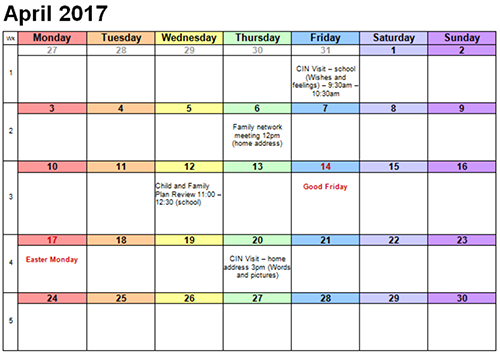1.3.6 Trajectories Guidance
SCOPE OF THIS CHAPTER
Trajectories are the timelines to which safety planning, reunification, or support to families will be delivered. Trajectories hold clear goals, steps and timeframe to assist the family to know and understand what the safety planning process will involve for them.
When preparing trajectories, it is advised that you draft this and have this agreed within your professional network before this is shared with the family and network. This is to be sure that the agencies are in agreement to the plan and will work with you to deliver it.
Trajectories will be the tool which enable you will monitor the progress of the situation.
This chapter was added to the manual in August 2021.1. Bottom Line Requirements
These are the 'what the family MUST do before you will close the case/return a child home' (or complete your desired assessment outcome). This is not a list of do's and don'ts, and usually includes:
- The creation of a Safety Plan;
- That there is a network involved to manage, support and review the Safety Plan;
- That there is a words and pictures explanation created, that will support the network to create a child friendly version of the Safety Plan;
- That there is a contingency plan – so that the family and network will know what will happen if the safety goals are not met.
2. Next Step – Deciding the Timescales
You need to consider the timescales when developing the trajectory. There is no defined timescale for reunification or case closure, it needs to be child and family specific, considering needs, age, and complexities.
Questions to consider are:
- How old is the child?
- How serious are the concerns?
- Has immediate safety planning with wider family and network been completed?
- What sort of work do we think needs to happen?
- Trauma informed – how risky is reunification/child remaining with the family?
- Direct work with the child/ren – how will they be involved in the plan?
- What help might the children, parents and others need?
3. Parents/professional network actions
- Family (Safety) Networks and Family Network Meetings to be identified and worked through;
- Narrative work with parents (or separately) to go through the trajectory and plans;
- Look at the impact of the risks/adult behaviour on the relationships;
- Safety Plan reviews.
4. Involving the children in the Safety Plan and Trajectory
- Direct work with Children: Voice of the child is captured
- Wishes and feelings (3 Houses, Safety House)
- Safe hands
- Words and pictures explanations – making sure the children know what the worries are and what is being done about it.
- Children testing the safety plan with the use of the safety object (if appropriate)
- Regular visits (as per policy)
- Reflective work with children; re visiting the direct work.
Tips
- Within the 'Date' column, please be specific with dates;
- Within the 'Action' column, please be SMART with the actions being recommended or completed;
- Update progress in the 'Meetings/Monitoring' column as you go along. Details delays experienced and utilise this template as your evidence of progress log;
- In the 'Contact' column, make sure you update progress here too.
Templates
Table format:
| Date | Action | Meetings/Monitoring | Contact |
| Week 1 | Identify safety network |
Initial network meeting |
Contact to be 3 times a week with mum and between siblings. Fortnightly with dad. |
| Week 1 | Develop Safety Plan – share this with network and review network meeting, make sure everyone has a copy. | Within initial network meeting. Review and practice in week 2 | |
| Week 1 | Begin creating words and pictures explanation to share with children with parents. | ||
| Week 1 | Start a safety journal. | Review at first review network meeting in week 2. | |
| Week 2 | Visit to parents to continue work on the words and pictures explanation. | ||
| Week 2 | Review Safety Plan – put this into words and pictures ready to share with the children. | First review network meeting. Practice the plan with network and address. |
Diary format: it might be that you have both versions; table format for the full version, and diary format to demonstrate key activity to remind the family/children.

5. Reunification/Closure Checklist – What to Consider in Your Trajectory Plan
The following should be considered in your trajectory plan when closing a case or undertaking a reunification.
- Meetings with the family;
- Discussions with the Independent Reviewing Officer/Child Protection Chairs/Fostering Team/Adoption Team and other professionals;
- Opportunities to review historic information (if not known);
- Assessment visits;
- Direct work visits and sessions;
- Words and Pictures sessions with parents;
- Family Network Meetings;
- Contact changes and contact review;
- Outcome meetings;
- Return home plan meetings – if appropriate;
- Return home dates – if appropriate.
